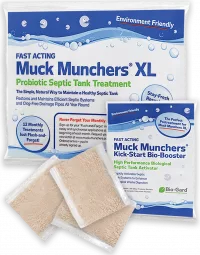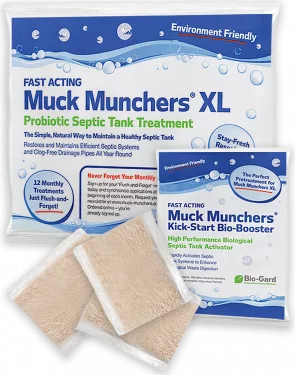Domestic Wastewater Treatment Plants v Septic Tanks – What’s all the Confusion?
Are you confused about the difference between different types of septic systems? And are there any differences between Domestic Wastewater Treatment Plants v Septic Tanks?
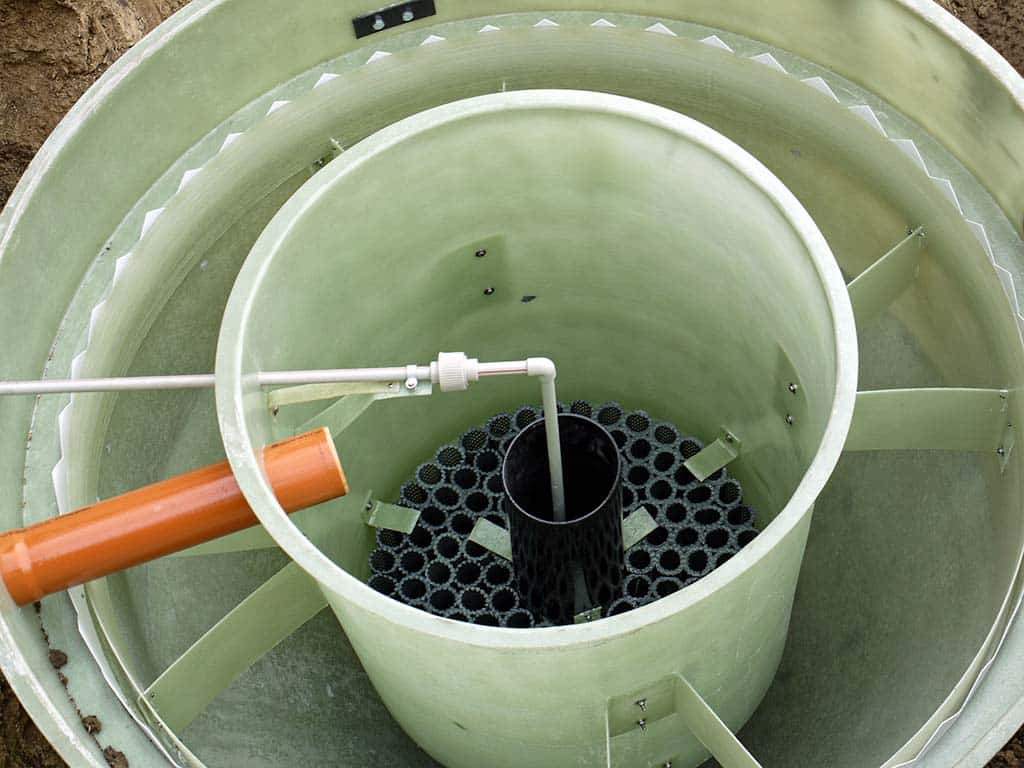
The whole subject debate around domestic wastewater treatment plants v septic tanks is further confused by other terms used as synonyms for a Septic Tank. So first, let’s clear up the difference between Septic Tanks and Cesspits, or as occasionally called Cesstanks.
A Septic Tank is a traditional onsite wastewater treatment system (OSWTS). It is a system that takes effluent from the home, and digests the organic waste content, to create clearer, purer water that can be discharged safely to the environment through a soakaway system.
By contrast, a Cesspit or Cesstank (effectively a pit with a lid on top, of some sort) is nothing more than a holding unit. It has no drainage system, no soakaway – it acts purely as a holding tank. With no drainage, it means that when it’s full, it’s full and needs to be emptied. Few properties in the UK have a Cesspit or Cesstank, except where soakaways are impractical for natural drainage to occur.
How Does a Septic Tank Differ from a Domestic Wastewater Treatment Plant?
Moving back to the original question, regarding domestic wastewater treatment plants v septic tanks. Septic Tanks and Wastewater or Sewage Treatment Plants rely fundamentally on the same technology to treat wastewater and digest the organic waste materials it contains.
This technology relies first on having a very healthy bacterial population that can break down waste into smaller molecules and then digest it. To do that the bacteria need oxygen and water moisture. The higher the oxygen levels in the system the higher the rate of digestion and hence the more effective it is.
Wastewater Treatment Plants fundamentally just make more oxygen available to the bacteria. Septic Tanks rely on the available oxygen dissolved in the effluent flowing into the tank and absorbing oxygen from the air above the surface of waste liquid.
Treatment plants ensure this higher level of oxygen by using various electro-mechanical engineering approaches to power compressors to simply pump air into an active digestion chamber or pump the waste through or over a variety of materials exposing the waste to higher levels of oxygen.
To illustrate the differences of domestic wastewater treatment plants v septic tanks, here are two comparative illustrations of a traditional Septic Tank and Treatment Plant.
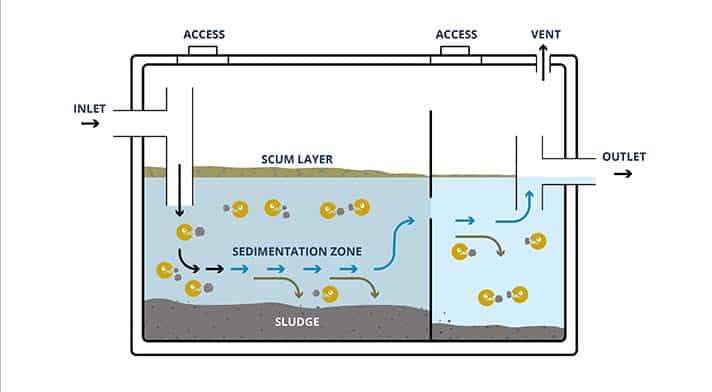
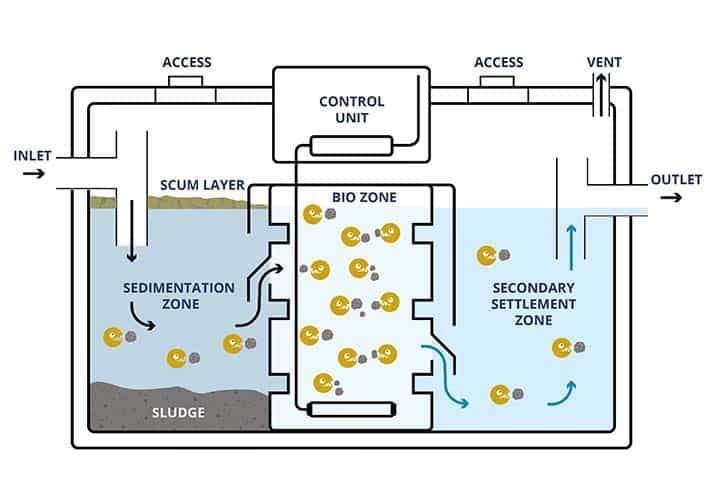
The basic Septic Tank concept consists of two chambers, or more, and has existed for literally hundreds of years. Domestic wastewater drains into the first chamber, creating three layers as shown in the above illustration – in the first chamber, there will be a scum layer on the surface comprising fats, oils and grease along with recent additions of paper and ‘floaters’; a fluid middle layer, where bacteria will be very active; a sludge layer at the bottom, comprising heavier organic and inorganic material. In a healthy, bacteria-rich, Septic Tank treated with Muck Munchers, this layer will minimal. Partially treated wastewater then flows into a secondary chamber where it continues to be digested before it is discharged to the soakaway.
The modern Sewage Treatment Plant is very similar. In the illustrations above, you can view the basic principles of what is known as a Fixed Bed Bioreactor (FBBR), the activity in the first tank is very similar to the traditional Septic Tank. The real difference occurs when the partially treated waste enters the ‘Bio Zone’ where, because air is pumped through a diffuser at the bottom, there is a much higher level of bacterial activity, resulting in very pure effluent entering the final secondary sediment zone.
The 6 Types of Sewage Treatment Plants
When buying a Sewage Treatment Plant, there is an array of different types. Which type is suitable to meet your needs will depend upon a number of factors, most importantly – the visibility above ground of the unit at your property, purchase price, installation costs, maintenance and electricity costs, plus spares and replacements.
Various types of domestic wastewater treatment plants are available. Prior to purchase, you would be well advised to discuss the most suitable option for your particular needs with an established distributor that offers a range that will include some or all of the following options:
Fixed Bed Bioreactor – FBBR
- Compact and reliable
- Low installation costs
- Low maintenance costs
- Control unit and compressor above ground
- Compressor likely to run 24 hours per day
Moving Bed Reactor – MBBR
- Similar to a Fixed Bed Bioreactor
- Likely to be more energy efficient
- Better visual impact
- Low maintenance costs
- Check Installation costs
Activated Sludge Plant – ASP
- Low purchase cost
- Installation costs can be higher
- Low maintenance costs
- Check electric running costs
Sequential Batch Reactor – SBR
- Purchase cost likely to be high
- Low installation costs
- Control unit and compressor above ground
- No mechanical or electrical parts in tank
Rotating Disc System / Rotating Biological Contactor
- High-performance proven system
- Low running costs
- Check maintenance and parts costs
Non-Electric Sewage Treatment Plant
- High initial cost
- Check maintenance and parts costs
- Zero electric running cost
- Completely silent
- May require a pumped outlet
Why is there Confusion Between Domestic Wastewater Plants v Septic Tanks?
In our opinion the answer is straightforward. Most people who have an onsite wastewater treatment system (OWTS), simply refer to it generically as a Septic Tank, irrespective of anything else. The terms ‘Septic Tank’ and ‘Domestic Wastewater Treatment Plant’ or just ‘Treatment Plant’ are used interchangeably. Well, that is unless the Septic Tank is a traditional type, where the terms ‘Cesspit’ or ‘Cesstank’ may also be used generically. Confusion? No wonder.
Can I use Muck Munchers in my Domestic Sewage Treatment Plant?
Yes, you should use Muck Munchers in your domestic Sewage Treatment Plant. Essentially, these microbes will do much the same job as you’d expect them to do in a Septic Tank. That’s because both types of systems depend on bacteria to digest organic waste.
Without healthy bacteria in your tank or treatment plant, you’re at risk of digestion grinding to a halt. This can cause serious blockages and damage to soakaways and can result in severe damage within treatment plants too.
In Summary – Domestic Wastewater Treatment Plants v Septic Tanks
- Septic Tanks are less expensive than Treatment Plants to both buy and install.
- Domestic Sewage Treatment Plants largely rely on electricity (though some are gravity-based), which can be costly to run while Septic Tanks require no such hook-up.
- Both domestic Sewage Treatment Plants and Septic Tanks may need to be emptied from time to time. Maintaining a healthy bacterial population with Muck Munchers will extend the time interval between emptying significantly, for both types of system.
- Domestic Sewage Treatment Plants need specialist annual maintenance checks and may well require components to be replaced.
- You may discharge waste directly into a watercourse from a Treatment Plant, whereas this is illegal for Septic Tanks.
- Using Muck Munchers in Sewage Treatment Plants will, apart from optimising digestion, reduce wear and tear on any mechanical and pump components in waste digestion chambers.
